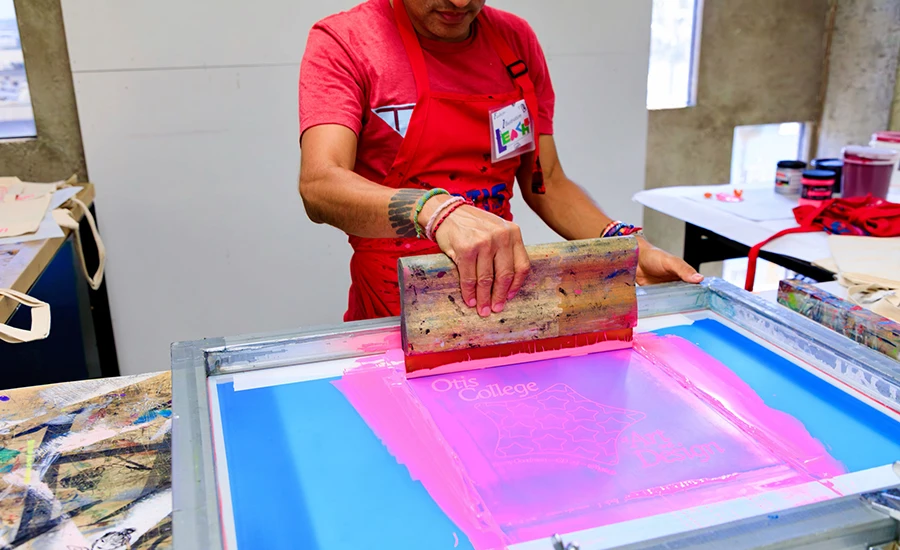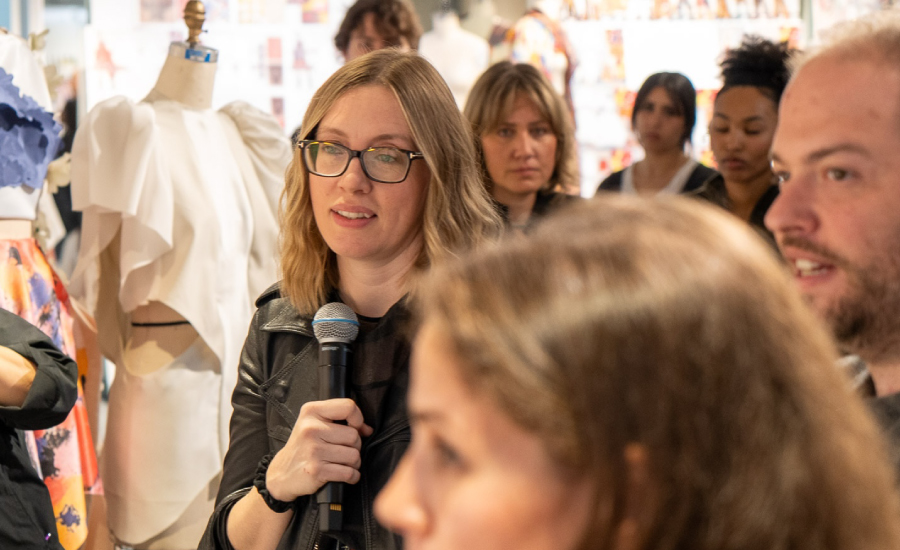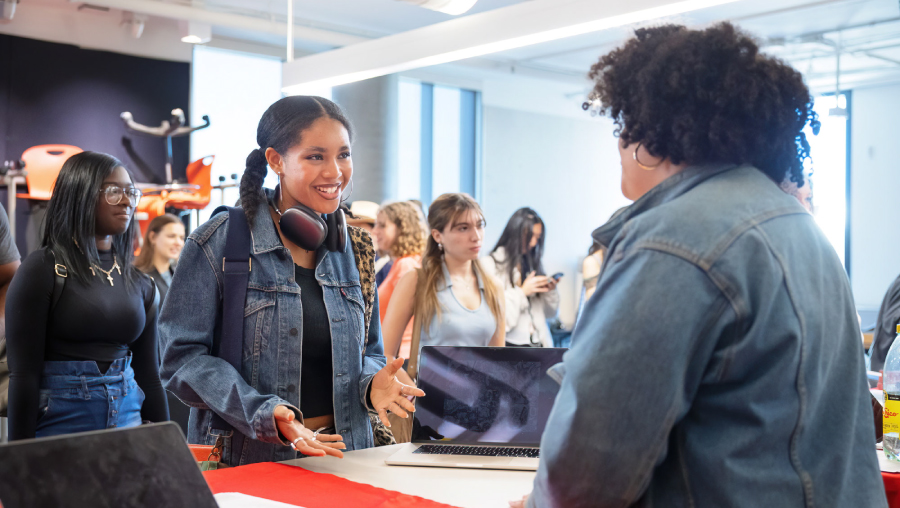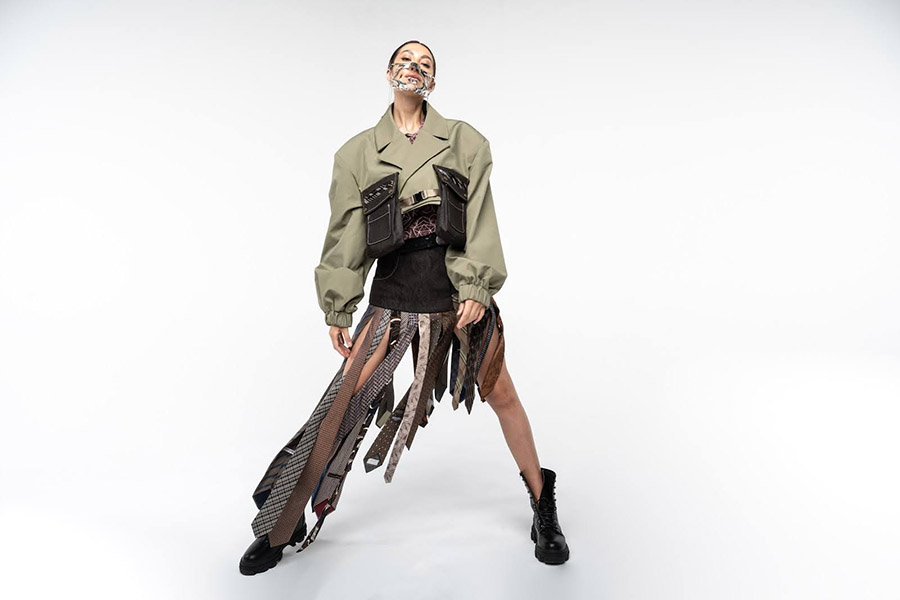Otis Design Lab Upcycles Campus Banners into Stylish Tote Bags
“We’re the future of design, and it’s our job to consider the impact of our creations.”

Product Design faculty Karen Regoli-Arthur had often spied the colorful pole banners hanging above the Otis College campus, wondering what happened after they came down. “I had an epiphany about reusing them in a sustainable way, possibly making them into products such as pencil cases, wallets, and totes,” she says. Regoli-Arthur asked around and was connected to Emily Carlson, Otis’s Creative Director, who manages the design and installation of pole banners on campus and happily gave Regoli-Arthur some discarded banners for her studio class.
“The class was tasked with upcycling the outdoor vinyl banner material into useable products—everything from raincoats to pet coats, grocery bags to luxury totes,” says Regoli-Arthur. “The projects were very successful, and the students enjoyed the experience of discovering the possibilities of the unique and, of course, ‘free’ material. There were so many possibilities!”
The goodwill behind the successful project reverted back to Carlson when Regoli-Arthur invited her to see the students’ work. Carlson also is the Director of Otis Design Lab, the only design studio in Los Angeles that functions as a collaboration between students, staff, faculty, and external clients. Thus the Design Lab Tote project was born.
Street pole banners are ubiquitous across the Los Angeles cityscape, signaling to passersby upcoming museum exhibitions, zoo attractions, neighborhood festivals, and other cultural happenings. The Los Angeles Bureau of Street Lighting issues permits for over 31,000 banners a year, many of which are replaced with new campaigns multiple times. This results in a significant number of leftover banners that are most often produced on vinyl, a nonbiodegradable material that is difficult to recycle but that can be reused or upcycled.
Instead of adding to the waste, let’s use recycled materials to transform what would become trash into something beautiful and useful.”
This material challenge presented a learning opportunity for Design Lab to develop new merchandise for Otis College with a focus on sustainability and the connections between student-created work and the Otis community. The resulting products are tote bags that are sold in the on-campus location of Graphaids, an art supply store that acts as the College’s de facto bookstore, as well as the Otis Store online.
“It is extremely important for art and design students to get experience with sustainable projects,” Regoli-Arthur says. “We have a huge amount of creativity on our campus, and it needs to be used in imaginative ways. I am so over-the-moon excited and happy that the pole banners are being repurposed in very useful totes and that Design Lab students are gaining real experience working with Graphaids.”
A Big Production
The project also gave Design Lab students a chance to flex their skills as a full service design studio. In addition to product design and production, they created all of the promotional content around the launch. They art-directed photoshoots, shot and created video, and even designed a window display for the on-campus store.
“They participated in the entire life cycle of bringing a product to market,” says
Carlson. “From the first sketch to how their product would be marketed and displayed,
they had a hand in every decision, which is what makes this project so valuable.”
The Design Lab team for this particular project included Product Design seniors Nhan
Cao, Viviana Ley, Bona Nguyen, Aidan Quigley, and Steven Wiryopranoto, as well as
junior Lily Nguyen-Wilson. They began by researching products that would be great
for Otis-branded merchandise, identifying product gaps, and considering audience demographics.
They then met with faculty and administrators to define the goals and objectives for
the project. After the designers brainstormed their ideas through sketches, the design
chosen for further exploration was a tote bag with three pockets—inspired by the shape
of Otis’s logo and adding a functional element to the bag.
During the production process, the students learned to deal with production trade-offs and cost management. This led them to make design changes, developing unconventional methods to manufacture the bags in order to decrease production time. They even created a step-by-step list of the most efficient production processes to deal with the thick pole banner material. They learned first-hand that production is a critical part of the design process and pricing strategy, where the ability to take a design to market is tested and refined.
The banners-turned-tote bags feature illustrations by Genesis Otero (’24 BFA Animation). Elements of Otero’s design, which was originally produced as a mural on campus, also appeared in admissions materials to glowing reception from both current and prospective students.
“We had already heard wonderful feedback from the community whenever we featured Genesis’s illustrations, so we had a strong sense that people would love these tote bags,” notes Carlson.
Indeed, the limited “CAMPUS” series of tote bags released in late spring 2024 sold out within a matter of weeks. A new “MAJOR” series of totes just launched that are made out of pole banners featuring work by more recent Otis alumni across the College’s majors, including Derek Chiang (’22 BFA Product Design); Meka Tome (’22 BFA Fine Art); Alina Lalik (’21 BFA Digital Media); Wai Yan Cheung (’25 MFA Graphic Design); Venus Kohana (’24 BFA Illustration); Daiki Miwa (’22 BFA Digital Media); Yihan Lu and Lingxiao (’23 BFA Fashion Design); and Henry Polaha (’23 BFA Toy Design). The “MAJOR” limited series just dropped at Graphaids on campus and at the Otis Store online.
“As art and design students I think it’s super important to focus on sustainability and upcycling in our work. We’re the future of design, and it’s our job to consider the impact of our creations,” says senior Viviana Ley, part of the Design Lab team behind the totes. “Nearly every product eventually ends up in a landfill, often spending more time there than being used. With projects like this, we have a fantastic opportunity to give materials a new life instead of just throwing them away. Instead of adding to the waste, let’s use recycled materials to transform what would become trash into something beautiful and useful. This way, we can really reduce our impact on landfills and do our part to help the planet.”
To see more projects by Design Lab students, explore Design Lab’s portfolio for inspiration or a possible collaboration!
Related News



